2011 Snapshot Memories:
The 2011 PCA Convention
Washington, DC
by Dr. Ed Sheldon
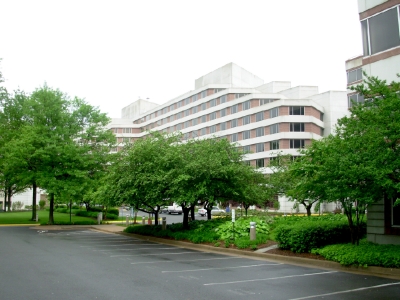
Hotel Hilton-McLean in Tyson's Corner
(click image to enlarge)
| |
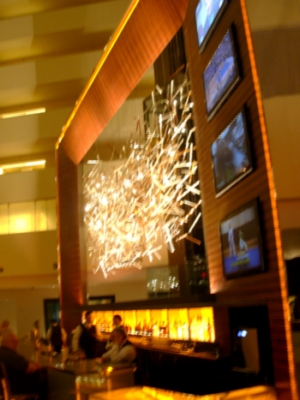 Hotel atrium lobby bar(click image to enlarge) Hotel atrium lobby bar(click image to enlarge) |
Upon my arrival at the McLean Tysons Corner Hilton on a recent May evening in advance of other early bird directors to set up the 2011 Paperweight Collectors Association Biennial convention, and stepping out of the spinning circular entry door, a designated host, smiling, thrust out a hand to greet and warmly welcome me. That tone and hospitable ambiance prevailed throughout the convention, earning earning plaudits from attendees. The welcome was summarily interrupted by the striking hotel lobby: over eight stories of open atrium, multistoried glass decorations illuminating the space and clusters of floor-level inviting, conversation nooks. There was glass everywhere — how appropriate! A very good start.
McLean, a demographically upscale community moments outside the DC beltway takes its name from co-developer John McLean, a former owner of the Washington Post and railroad entrepreneur. Our convention Hospitality Suite bore the name of his daughter-in-law, Evelyn Walsh McMcLean. Among her many baubles, the Hope diamond (now a permanent Smithsonian Institution property), a decoration with a storied past, associated with tragedy and sadness. Too bad we were too late to remedy that scenario with the healing powers of beautiful crystal paperweights.
Conventioneers, about two-hundred-fifty in all, trickled in, some also a bit early, taking advantage of an "extra feature" all day guided bus tour of Washington DC highlights that included notable monuments, architecturally important structures, and the White House. Reports from riders: "Excellent!"
The PCA board of directors, generously assisted by local volunteers, ensured registration of attendees was completed in time for the convention opening event, the Artist's Fair which was set up in The Atrium. This inviting space gave collectors the opportunity to mix socially and also interact, ooh and ah with artists showcasing their newest creations and initiate wish lists to execute at the Dealer's Fair which immediately followed. This event was generously enhanced with a libation bar and creatively arranged hotelhosted carving bar for sandwiches. Food, good company, drinks, and gorgeous glass art: very good!
| |
|
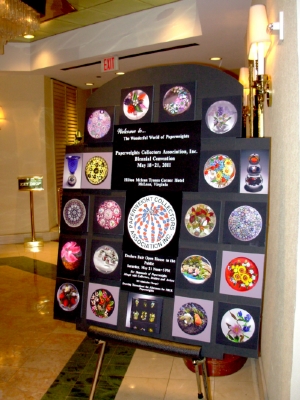 Convention Poster in hotel lobby(click image to enlarge) Convention Poster in hotel lobby(click image to enlarge) |
|
This convention hosted about fifty first-timers. PCA membership committee chair Deb Zonies actively solicited mentor volunteers to shepherd and facilitate introductions for the "newbies" to add comfort, orientation, and therefore enrichment to their new experience. It seems that it did not require a large contingent to accomplish the task: spontaneous openness and social interaction of attendees accomplished it without regimentation, testament to the friendly nature of this organization's members. It took no time for the newly indoctrinated to do their own thing with ease. They will be back
Dealers and Artist-Dealers with supplemental help manned fourteen booths in the Dealer Fair (you can't describe it, you have to see it) opened the event on Wednesday, day one, then recurring open periods throughout the convention found collectors going beyond the look and touchy-feely phase to active acquisition and fulfillment of impulses and longings. The dealers were invariably seen smiling as their subjects reduced inventory. A rich embellishment in the Dealer's Fair was the generously provided Special Exhibit of rare and unusual objects, including the famous Bird In Nest weight. The display was frequently lined with observers. Details and photos can be found in the 2011 Bulletin.
| |
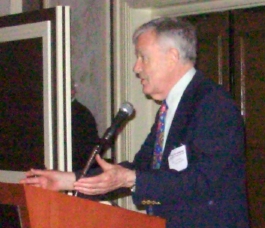 President Ben Drabeck at the podium(click image to enlarge) President Ben Drabeck at the podium(click image to enlarge) |
Didactic, educational lecture events opened the convention on Thursday preceded by greetings and announcements by PCA president Ben Drabeck (right), a retired English Professor in rare witty form.
Alan Thornton, a physicist by training and occupation, but a committed, well informed, scholarly collector by avocation, was handed the first presentation slot with his humorously labeled "If I Knew You Were Coming, I'd Have Baked a Fake" take off on an old tune. Paperweight fakes and/or inclusions, it seems, come in all sizes: intentional, presumed, inadvertent, interpretive, and even controversial. The audience was rapt, no doubt in part due to his charming "across the pond" accent. All were left with a new appreciation, and more cautious, but informed approach and curiosity about the subject.
John Hawley next took us on a tour of the glass flower gardens of the Boston and Sandwich, New England, Union, and Mt. Washington glass factories. Aside from showcasing the many varieties, he provided design clues, i.e. silly little hats (you had to be there) that could help identify which factory (or which glassworker) made which weight. It was interesting to see how the immigrant glass workers often tried (with varying degrees of success) to duplicate the flower paperweights of the great French glass houses as well as develop uniquely American designs such as the Sandwich weedflower. It was evident from the wide range of flower paperweights illustrated, from a simple Sandwich poinsettia to a magnificent magnum floral bouquet attributed to Mt. Washington, that the American glassworkers demonstrated artistic skills equal to those of their European counterparts.
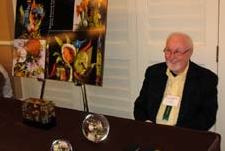 Paul Stankard Paul Stankard |
|
Paul Stankard (left), a name, personality, and artist of wide renown, is no stranger to the members of this collecting group. Many have heard him speak, read his books, admired and maybe even collected his work and in the process witnessed the evolution of his artistic path. On this occasion, "Andrew Page in Conversation with Paul Stankard: A New Way of Seeing the Work of Paul Stankard" presented Paul and his work in new light. Mr. Page, the editor of Urban Glass/Glass Quarterly, guided and moderated the conversation, detailing Paul's personal/ artistic journey and challenges, punctuated with insightful questions for Paul's comments and elaboration in his own very personal and subjective style. The transformation of work from conventional paperweight format to more sculptural forms, inclusions of organic/reproductive identity elements and human forms, as well as true to life representations of flora and biology were probed and extracted in this gently conducted but insightful collaboration. A large format, liberally and beautifully illustrated book encompassing the Paul Stankard story and work is in publication with an early release scheduled this summer.
The noon time period on day one gave attendees the opportunity to have lunch with artists in more informal and conversational, intimate groups. Box lunches were the fare of the day. Artists participating and presenting included: Drew Ebelhare & Sue Fox, Colin Richardson, and Virginia Wilson Toccalino. The format is particularly enticing to new members who have not interacted with artists before, but remains a popular venue for old timers as well.
In the lone presentation on Thursday afternoon, Jim Lefever (a PCA past president) renewed our interest in paperweight related objects. He immediately caught our attention by bringing out two objects for show and tell to illustrate the extremes of this collecting category; a small hand cooler and a 29" tall candlestick. It soon became apparent to this admittedly biased audience that such ordinary items as curtain tiebacks, doorknobs, vases, and inkwells were truly enhanced in both appearance and value by their paperweight related theme.
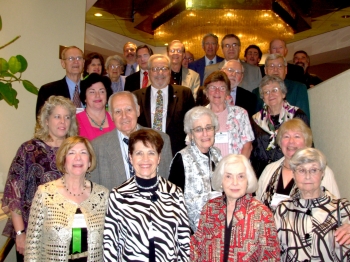 The Delaware Valley chapter at the Convention(click image to enlarge) The Delaware Valley chapter at the Convention(click image to enlarge) |
The Thursday evening "dutch treat" dinner was by sign-up arrangement with a host for each group. A plethora of fine quality dining establishments in the hotel vicinity and courtesy hotel shuttle to some made this event an easy success. Convention registration included three very nice buffet breakfasts in the hotel. The Harth, a high quality restaurant off the hotel lobby was also available for alternative dining all three meals of the day and was a frequently visited spot as was a lobby-adjoining bar.
An evening event moderated by Jan Smith, Executive Director of the Bergstrom- Mahler Museum, capped the day. She interacted with a panel of four artists: Rick Ayotte, Peter McDougall, Cathy Richardson, and Daniel Salazar on the subject "The Art in My Paperweight." In a comprehensive and well organized preview by projected slide images, Jan enumerated in detail the toolbox for the artistic production of weights: historical influences, materials, techniques, and inspirational elements, to list just a few of the many that result, or can result in weights we know, have known, or would like to know. Artist's comments volunteered or responses to probes from the moderator invariably reflected their own very personal experiences: artistic inspiration, work experience and opportunities, and also the technical challenges to expand their designs and goals.
| |
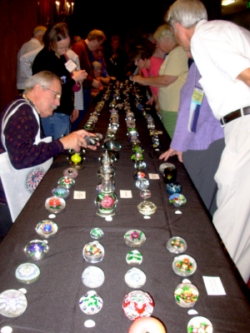 Exhibit of Smithsonian Exhibit of Smithsonian
paperweight collection(click image to enlarge) |
Friday, the day of anticipation, offered the Pièce de Resistance, a visit to The Smithsonian Institution to witness the display of the unveiled paperweight collection. Delightful and charming Susie Kaplan Jacobson gave an introductory historical presentation to prepare visitors for the exhibit. Detailed information can be found in the catalog of the collection produced by PCA. A huge amount of planning effort, time, and generosity, not magic, resulted in this once in a life-time opportunity. The display, an exclusive, private affair for PCA convention registrants, was mounted in The Presidential Room, an impressive venue: carpeting, paneled walls, and one very long table with four rows of the assembled weights (right). Orderly columns of enthusiastic collectors snaked their way around the exhibit tables. Plenty of oohs, ahs, and camera flashing activity was witnessed. A caravan of buses carried convention registrants to the Smithsonian with round-robin cycled returns to the convention hotel. Memories of this experience will be the grist of comment and conversation for a long time to come.
Saturday, the closing day of the convention, began with Ed Poore, the magician, sharing with us the narrative of his initiation into the world of glass; a simple and humble beginning. And then, on the projection screen, image after image of apparently hopelessly damaged or abused paperweights and other glass objects were transformed into resuscitated beauties, testament to the skills and artistry Ed acquired over years of experience. The embellishment cutting, shaping, fancywork, etc. of new work by contemporary artists also reinforced the treasure this man is to the world of glass.
A mandated Business meeting of the PCA gave members reports from officers and directors on the activities, finances, and new directors in the organization. This interlude was immediately followed by a very popular and regular convention feature, The ID Clinic.
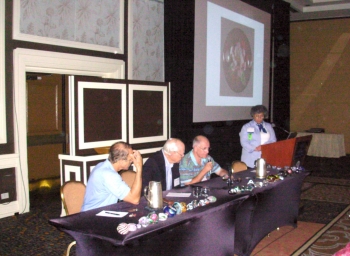 ID Clinic with Gary Underwood, Jerry Gard and Alan Thornton. Deb Zonies moderating.(click image to enlarge) ID Clinic with Gary Underwood, Jerry Gard and Alan Thornton. Deb Zonies moderating.(click image to enlarge) |
ID Clinic Panel members Jerry Gard, Alan Thornton, and Gary Underwood (above) faced over forty weights submitted by convention guests for diagnosis or paternity. Deb Zonies, the moderator, was challenged to keep order, prevent mayhem amongst the panel, and keep the show moving which she accomplished with wit and threat. It seems that Chinese and Murano dominated the basket of unknowns with a few quirky subjects thrown in. No truly marvelous prized jewels were forthcoming. This animated, sometimes controversial feature always captures the audience.
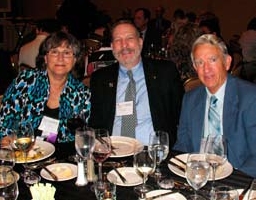 Gay LeCleire Taylor, Andrew Dohan, Gay LeCleire Taylor, Andrew Dohan,
and John Hawley |
|
Early afternoon on closing day Gay LeCleire Taylor (left, with Andrew Dohan and John Hawley), Curator Emeritus of the American Museum of Glass at Wheaton Village, presented "Paperweight Primer", the subject material abundantly disclosed in the title. Aimed at new collectors and also guests present for the public open-house, the liberally illustrated lecture captured history, tools, materials, and methods, demystifying how paperweights were born and how they are made. We hope to capture new aficionados with this presentation.
Convention 2011 finale, the Saturday evening banquet was a final opportunity to socialize, reminisce and share experiences, acquisitions, and appreciate new friendships. Ben Drabek acknowledged departing Directors, introduced newly installed Directors, and invited all to hold their breaths in anticipation of an announcement in the months ahead about the next convention site, yet to be chosen. Deb Zonies, assisted by local chapter presidents, distributed door prize gifts, generously donated by the dealers in attendance.
|